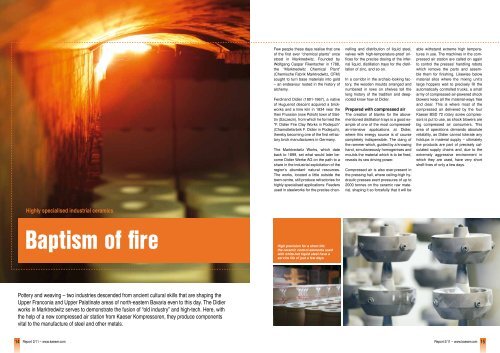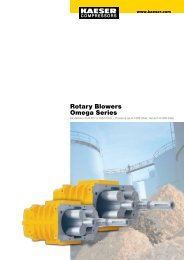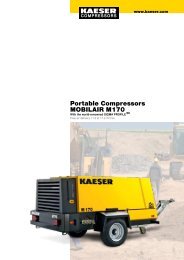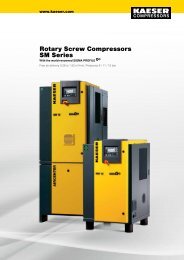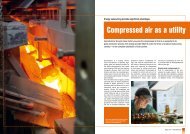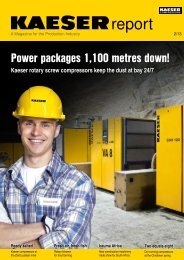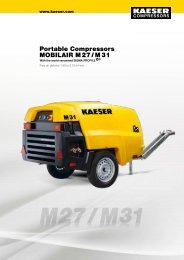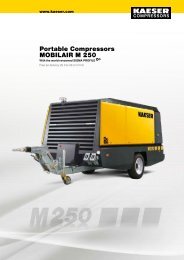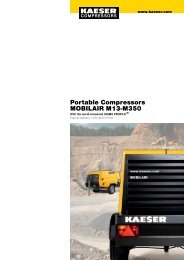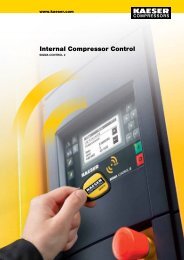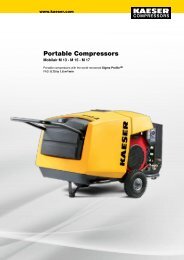Baptism of fire - Kaeser Kompressoren
Baptism of fire - Kaeser Kompressoren
Baptism of fire - Kaeser Kompressoren
Create successful ePaper yourself
Turn your PDF publications into a flip-book with our unique Google optimized e-Paper software.
Few people these days realise that one<br />
<strong>of</strong> the first ever “chemical plants” once<br />
stood in Marktredwitz. Founded by<br />
Wolfgang Caspar Fikentscher in 1788,<br />
the “Marktredwitz Chemical Plant”<br />
(Chemische Fabrik Marktredwitz, CFM)<br />
sought to turn base materials into gold<br />
– an endeavour rooted in the history <strong>of</strong><br />
alchemy.<br />
Ferdinand Didier (1801-1867), a native<br />
<strong>of</strong> Huguenot descent acquired a brickworks<br />
and a lime kiln in 1834 near the<br />
then Prussian (now Polish) town <strong>of</strong> Stettin<br />
(Szczecin), from which he formed the<br />
“F. Didier Fire Clay Works in Podejuch”<br />
(Chamottefarbrik F. Didier in Podejuch),<br />
thereby becoming one <strong>of</strong> the first refractory<br />
brick manufacturers in Germany.<br />
The Marktredwitz Works, which date<br />
back to 1899, set what would later become<br />
Didier Werke AG on the path to a<br />
share in the industrial exploitation <strong>of</strong> the<br />
region’s abundant natural resources.<br />
The works, located a little outside the<br />
town centre, still produce refractories for<br />
highly specialised applications: Feeders<br />
used in steelworks for the precise channelling<br />
and distribution <strong>of</strong> liquid steel,<br />
valves with high-temperature-pro<strong>of</strong> orifices<br />
for the precise dosing <strong>of</strong> the infernal<br />
liquid, distillation trays for the distillation<br />
<strong>of</strong> zinc, and so on.<br />
In a corridor in the archaic-looking factory,<br />
the wooden moulds arranged and<br />
numbered in rows on shelves tell the<br />
long history <strong>of</strong> the tradition and deeprooted<br />
know how at Didier.<br />
Prepared with compressed air<br />
The creation <strong>of</strong> blanks for the abovementioned<br />
distillation trays is a good example<br />
<strong>of</strong> one <strong>of</strong> the most compressedair-intensive<br />
applications at Didier,<br />
where this energy source is <strong>of</strong> course<br />
completely indispensible. The clang <strong>of</strong><br />
the rammer which, guided by a knowing<br />
hand, simultaneously homogenises and<br />
moulds the material which is to be <strong>fire</strong>d,<br />
reveals its raw driving power.<br />
Compressed air is also ever-present in<br />
the pressing hall, where ceiling-high hydraulic<br />
presses exert pressures <strong>of</strong> up to<br />
2000 tonnes on the ceramic raw material,<br />
shaping it so forcefully that it will be<br />
able withstand extreme high temperatures<br />
in use. The machines in the compressed<br />
air station are called on again<br />
to control the presses’ handling robots<br />
which remove the parts and assemble<br />
them for finishing. Likewise below<br />
material silos where the mixing unit’s<br />
large hoppers wait to precisely fill the<br />
automatically controlled trucks, a small<br />
army <strong>of</strong> compressed-air-powered shock<br />
blowers keep all the material-ways free<br />
and clear. This is where most <strong>of</strong> the<br />
compressed air delivered by the four<br />
<strong>Kaeser</strong> BSD 72 rotary screw compressors<br />
is put to use, as shock blowers are<br />
big compressed air consumers. This<br />
area <strong>of</strong> operations demands absolute<br />
reliability, as Didier cannot tolerate any<br />
holdups in material supply – ultimately<br />
the products are part <strong>of</strong> precisely calculated<br />
supply chains and, due to the<br />
extremely aggressive environment in<br />
which they are used, have very short<br />
shelf-lives <strong>of</strong> only a few days.<br />
Highly specialised industrial ceramics<br />
<strong>Baptism</strong> <strong>of</strong> <strong>fire</strong><br />
High precision for a short life:<br />
the ceramic control elements used<br />
with white-hot liquid steel have a<br />
service life <strong>of</strong> just a few days<br />
Pottery and weaving – two industries descended from ancient cultural skills that are shaping the<br />
Upper Franconia and Upper Palatinate areas <strong>of</strong> north-eastern Bavaria even to this day. The Didier<br />
works in Marktredwitz serves to demonstrate the fusion <strong>of</strong> “old industry” and high-tech. Here, with<br />
the help <strong>of</strong> a new compressed air station from <strong>Kaeser</strong> <strong>Kompressoren</strong>, they produce components<br />
vital to the manufacture <strong>of</strong> steel and other metals.<br />
14<br />
Report 2/11 – www.kaeser.com<br />
Report 2/11 – www.kaeser.com 15
Fire and sand<br />
In order to live up to their <strong>fire</strong>-resistant<br />
reputation, ceramics must first go<br />
through <strong>fire</strong> themselves. Above gas<br />
flames in tunnel or hood kilns, the s<strong>of</strong>t<br />
raw material has to be subjected to temperatures<br />
<strong>of</strong> up to 1600 °C in order to be<br />
transformed into a high-strength “body.”<br />
And <strong>of</strong> course, compressed air comes<br />
into play again here, where it used to<br />
raise and precisely maintain combustion<br />
temperatures. <strong>Kaeser</strong> <strong>Kompressoren</strong>’s<br />
screw compressors even have<br />
a role to play in the finishing process,<br />
supplying energy to a large sandblasting<br />
station and an automatic lapping<br />
machine.<br />
More compressed air,<br />
more heat recovery<br />
Following a recent air demand analysis<br />
(ADA), a new compressed air station<br />
was installed that was designed and tailored<br />
to suit Didier’s exact compressed<br />
air requirements. The station comprises<br />
four <strong>Kaeser</strong> BSD 72 rotary screw<br />
compressors and three energy-saving<br />
TE 141 Secotec refrigeration dryers,<br />
which ensure that the compressed air<br />
is always dried to suit the needs <strong>of</strong> the<br />
specific application. An air main charging<br />
system guarantees that air quality<br />
is maintained after periods <strong>of</strong> low load<br />
or downtime by preventing the dryers<br />
from being overwhelmed by the sudden<br />
surge in airflow that occurs when<br />
the system re-starts. Air treatment performance<br />
is therefore safeguarded right<br />
from the start.<br />
All four compressors in the new station<br />
are equipped with heat recovery and<br />
consequently further contribute to enhanced<br />
energy savings. The recovered<br />
energy is used to heat service water,<br />
thereby reducing gas consumption by<br />
around 1400 kW/h per month – a fact<br />
that greatly pleases Toni Brasavs, the<br />
Technical Manager at the Didier Marktredwitz<br />
works, which have been owned<br />
by Viennese company RHI AG since<br />
1995.<br />
Author: Klaus Dieter Bätz<br />
Contact: klaus-dieter.baetz@kaeser.com<br />
RHI – The world’s leading<br />
refractories company<br />
The international RHI group manufactures<br />
and sells essential refractory<br />
products for all industrial high-temperature<br />
processes.<br />
RHI AG employs 7100 people and<br />
turns over around €1.6bn (2008/2009<br />
business year), its 32 sites across four<br />
continents produce some two million<br />
tonnes <strong>of</strong> refractories each year. Key<br />
industries such as iron and steel, cement,<br />
lime, glass, non-ferrous metals,<br />
environmental, energy technology, and<br />
chemical are the most important consumers<br />
<strong>of</strong> their products, systems and<br />
services. RHI Refractories are also involved<br />
in special ceramics, kiln furniture<br />
and raw materials. Under RHI’s ro<strong>of</strong> are<br />
a number <strong>of</strong> established brands, including<br />
Veitscher, Didier, Radex, Refel, Dolomite<br />
Franchi and Interstop, combining<br />
tradition with innovative technology and<br />
exemplary quality.<br />
Compressed air from the new <strong>Kaeser</strong><br />
station is also essential to the<br />
finishing process (left and opposite)<br />
16<br />
Report 2/11 – www.kaeser.com<br />
Report 2/11 – www.kaeser.com 17


